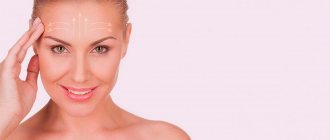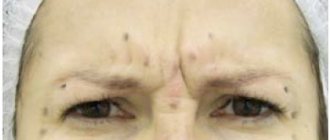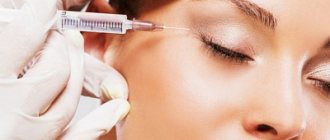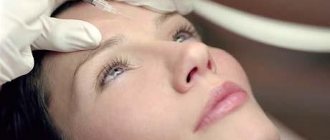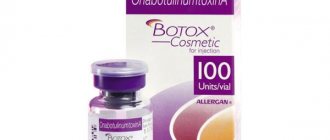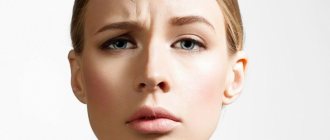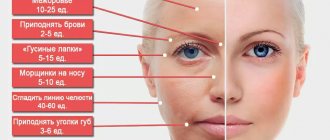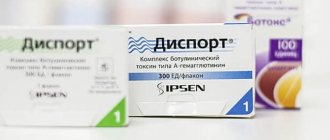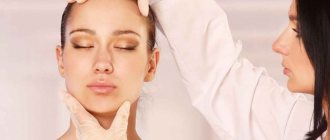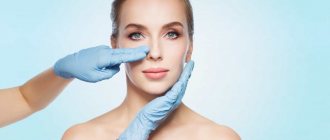Today, injections (injections) of botulinum toxin type A (or Botox) are the most common and minimally invasive cosmetic procedure in many countries, especially in Europe, Russia and the USA.
The drug is actively used in neurology, cosmetology, plastic surgery and reconstructive surgeries. Using fairly simple micro-injections, the drug is injected under the skin or into facial muscles and causes temporary relaxation (or a decrease in the intensity of muscle contraction), thereby achieving the effect of smoothing out first dynamic and then static facial wrinkles. Botulinum toxin type A (Botox) is used in therapeutic micro-doses and is absolutely safe. Botox has its unsurpassed anti-aging effect, although it is the most powerful poison on earth.
What are Botox injections used for in cosmetology and plastic surgery?
- Botox injections (botulinum therapy) are used to smooth out and correct hyperkinetic folds - facial wrinkles in the forehead, between the eyebrows, outer corners of the eyes (crow's feet wrinkles), longitudinal wrinkles of the bridge of the nose, vertical fine wrinkles of the upper and lower lips, and folds of the chin , reducing the severity of horizontal wrinkles in the neck and décolleté area.
- With Botox injections you can lift the eyebrows, the corners of the mouth, slightly tighten the oval of the face, and raise the tip of the nose.
- Botulinum therapy can also be used to improve the results of plastic surgery both before and after surgery.
What is the ideal age for Botox?
The use of Botox can be the norm both at 25 and at 60. Injections help to cope with wrinkles that can appear both at a young age, for example, due to a love of sunbathing, and at a more mature age, due to natural causes. It is worth noting that Botox can help get rid of even quite deep wrinkles, however, the older the person, the lower the skin regeneration, and the slower the process of smoothing out wrinkles on the skin will be. Especially if a person has loose skin that sags in the cheeks or eyelids. In such cases, you need to consult a surgeon, because it is possible that Botox will be just an unnecessary waste of time and money when plastic surgery could be a better option.
What drugs are used
First generation drugs include Botox and Dysport, although they are also effective today.
But over a period of more than 30 years, laboratories around the world have produced many similar drugs under different names, for example Rifinex, Lantox, Xeomin, the properties of which are superior to their predecessors, and the active ingredient in them is the same botulinum toxin type A.
For example, the latest generation drug, Relatox, due to modern production technology and stabilization of the toxin, in comparison with Botox, has shown less reactogenicity (the ability to produce antibodies in our body), a longer duration of effect with a greater degree of smoothing of facial wrinkles.
The history of the discovery of “sausage poison”
Botox is a drug based on botulinum toxin, the STRONGEST POISON of organic origin known to mankind. Botulinum venom is a neurotoxin, meaning it paralyzes nerve cells and thereby stops the transmission of information from them to the muscles. The body simply stops functioning. Botulinum toxin has the ability to paralyze muscles and is used in cosmetology to smooth out wrinkles.
Botulinum toxin is also called sausage poison. This is a literal translation of its Latin name: Botulinum toxin (Botulus - sausage). This poison was discovered at the end of the 19th century by the Belgian bacteriologist E. van Ermengen. He isolated the causative agent of fatal food poisoning from the remains of spoiled ham eaten by patients who died of progressive paralysis and named it Botulinum toxin.
Although before him, at the beginning of the 19th century, the German doctor Justinus Kerner was the first to describe in detail the clinical picture of botulism, a dangerous food poisoning known since the times of the Roman Empire. He investigated cases of mass fatal food poisoning (more than one and a half hundred (!) cases): he treated patients, dissected corpses, conducted experiments on birds, rabbits, cats, fish, to which he fed poisoned sausage and then dissected their carcasses.
Botulinum poison is produced by the merciless bacterium Clostridium Botulinum. You can find information that 4 kilograms of this bacterium is enough to destroy the entire population of our planet.
How does the procedure work?
- Patient and doctor.
- The patient is photographed before botulinum toxin is administered to compare the results after the procedure 10 days later.
- Skin treatment and drug administration.
- Within 1 hour after the procedure, the patient must make active facial movements.
- For 10 days you should not drink alcohol, take antibiotics, sunbathe, or perform any procedures on your face.
PS:
I recommend that everyone who strives for beauty and its preservation try to develop an individual program for using botulinum toxin as the simplest and most effective means of aesthetic correction of facial wrinkles to preserve your youth. This is not an operation - it's really simple and fast! And it is not at all necessary to do injections all the time. It is enough to do them before the summer, when you will wrinkle the most, because of which dynamic wrinkles will gradually turn into static wrinkles (rest wrinkles), and it will be more difficult to fight them. And it is not at all necessary to use the entire face; sometimes it is enough to correct just one area and still get an excellent anti-aging result.
Karachausheva Aksana Georgievna
- Dermatologist, cosmetologist.
- Doctor of the highest qualification category for planning individual anti-age programs for facial and body rejuvenation.
- Specializes in a combination of modern hardware and injection techniques for skin rejuvenation and treatment. Proficient in the technique of facial contouring and harmonization of appearance while preserving natural beauty and individuality, all methods of nourishing and cleansing the skin. Treats rosacea, rosacea, acne and skin hyperpigmentation.
- He is fluent in the new concept of rejuvenation and non-surgical SMAS facial lifting using high-intensity focused ultrasound on the Ultraformer device.
Cost of BOTOX injection
| Cost in rub. | |
| Consultation with a cosmetologist* | 2 000 |
| Zone | Cost in rub. |
| Forehead | 5 000 |
| Between the eyebrows | 5 000 |
| Eye area | 5 000 |
| Correction of asymmetry of lip angles | 5 000 |
| Correction of purse-string wrinkles | 320 (1 unit) |
| Correction of neck wrinkles (correction of platysma muscle) | 320 (1 unit) |
| Correction of neck wrinkles (correction of horizontal rings of Venus) | 320 (1 unit) |
| Correction of masticatory muscles (correction of facial volume) | 6 000 |
* - when undergoing the procedure on the day of consultation, the consultation is free of charge
questions and answers ask a question the whole list >
Botox is a poison, is it dangerous for the body? Botox injections do not pose any danger to the human body if it is a certified drug and is administered by a specialist in the correct dosage. Botulinum toxin type A can disable the muscles of the respiratory system or heart only in a dosage of more than 5500 units, while for the effective correction of facial wrinkles no more than 35 units of the drug are required, and for the treatment of hyperhidrosis (excessive sweating) up to 100 units of Botox are injected into the armpit area .
How and when is the drug removed from the body? The drug is eliminated from the body naturally. The drug has an effect only in the area of its administration for the next 4 hours after the injection. The drug is then filtered by the kidneys and excreted from the body.
Is it possible to be allergic to Botox? The likelihood of an allergy to botulinum toxin type A is extremely low. These are cases of very rare individual intolerance to the drug.
Can Botox be combined with other skin rejuvenation injections? If the procedures are performed on different areas of the skin that are not adjacent to each other, there are no contraindications. But if rejuvenation procedures are performed on areas of the skin with common boundaries, they should not be done on the same day. Since injections with hyaluronic acid cause temporary tissue swelling, Botox injections can increase it. As a rule, the result of such actions is an unplanned effect from the procedure.
Is it possible to influence the duration of action of the drug? Unfortunately, it is not possible to prolong the effect of Botox. But to ensure that the effect of the drug does not end prematurely, every patient should know that the durability of the effect is reduced by RF lifting and microcurrent therapy in the injection area (since these procedures are aimed at restoring tissues, nerve fibers and receptors), massage of this area , thermal procedures, active sports activities and taking B vitamins.
Why did Botox injections begin to take effect for 5 months, and not 6-8, as it was before? The main reason for this reaction is good blood circulation in the body, the presence of immunity and the general natural change in skin parameters with age. In order for beauty injections to always give the desired result, it is recommended to use Botox injections no more than 2 times a year, do not rush to increase the initial dosage, and if it is insufficient, do not increase it significantly. Also, we recommend that all our patients observe active muscle time 2 times a year. This means that after the last Botox injection expires, and before injecting a new one, we recommend taking a “pause” of 1 calendar month to restore active muscle function.
all questions and answers >
How many injections are needed to achieve the effect?
To eliminate facial wrinkles, one procedure of botulinum toxin injection is enough. The procedure consists of several injections, the number of which depends on the area being corrected. So, if this:
- drooping corners of the mouth - 1 injection is given on each side of the mouth;
- folds on the neck - approximately 3 injections on each side of the fold;
- “crow’s feet” - 3-5 injections near each eye;
- “Purse-string” wrinkles, how many injections are needed, the doctor will tell you. Usually there are at least 6 of them in total;
- creases between the eyebrows - 3-4 injections on each side;
- About 10-15 injections are given to the forehead;
- if you are worried about armpit sweating, then about 30 injections are needed.
When calculating the number of injections, it is based on how many units of the drug are needed for a particular area. For example, about 20 units should be injected into the nasolabial folds, an average of 4 into the upper lip, and 50 units on each side into the armpits. The cost of the entire procedure depends on the number of injections.
After injections, the face does not begin to change immediately, but by 7-14 days the necessary muscles are completely immobilized. By this time, changes in the skin in the area where the injections were performed are also noticeable: it is smoothed out, its color and texture improve. This effect lasts for about 6 months, if all restrictions are observed - up to 8-9 months.
To get rid of sweating, you need to wait only 2-3 days after the injections. The result is noticeable within 4-6 months.
Leave feedback
-
- 19.03.2019
IngaTwice a year I do Botox injections in the area around the eyes and between the eyebrows. I started after I was 35, now I do it to maintain the effect. The result of rejuvenation is colossal! No one even suspects my procedures, since facial expressions remain natural. Here, many thanks to the professional doctors and cosmetologists of the clinic. The consultations are very helpful and the injections are great!
READ MORE
25.06.2018
Svetlana
I have been taking care of my face for a long time, periodically do biorevitalization and photorejuvenation of the skin, and based on my personal experience, I believe that Botox injections are the first procedure that every woman should do after 30 years. One procedure lasts me 7-8 months. The result is excellent, wrinkles on the forehead and around the eyes are smoothed out, they simply don’t exist! I'm in love with Botox!
READ MORE
05.06.2018
Elya
I am very happy that cosmetologists have developed such an effective way to combat wrinkles. I recommend to all!!! Very convenient, fast, and effective! I don’t always see the same cosmetologist, but I want to note that all the cosmetologists in your clinic are experienced, attentive and excellent professionals!
READ MORE
all reviews >
Temporal regions
Injections into the temporozygomatic branch of the trigeminal nerve are given in an "anatomical" rather than a "targeted" manner because the sensitivity reported by patients in this area is usually more diffuse in nature rather than specific to the anatomical location of the nerve's exit point from the temporalis fascia. Since the nerve anatomy in this area is very stable, an "anatomical" injection is sufficient. This point, described by Totonchi et al. [12], is usually located 1.7 mm lateral and 6 mm above the lateral canthus. This injection, originally described by Guyon et al. [16], infiltrates fan-shaped around the nerve into the temporal muscle. We also inject a small amount of Botox into the space just above the point where the nerve exits the temporalis fascia to ensure that the superficial portion of the nerve that lies outside the temporal region is adequately exposed to Botox (Figure 3). In our experience, the major drawback of the current neuropathology injection paradigm is that this nerve is not injected at the correct depth and location.
Figure 3
.
Injection sites in the temporal region. Image showing the connection of the auriculotemporal nerve (bright yellow), the temporozygomatic branch of the trigeminal nerve (dark yellow), and the anterior and posterior branches of the superficial temporal artery (red) to injection sites in the temporal region. The temporozygomatic branch of the trigeminal nerve is located in a different fascial plane compared to the auriculotemporal nerve, and the superficial temporal artery lies more lateral. 1. The area of injection into the temporomygomatic branch of the trigeminal nerve, which is usually located 1.5 cm behind the exit of this nerve from the deep temporal fascia; 2. Proximal to the auriculotemporal nerve – the point corresponding to the fascial compression bundles; 3. Distal to the auriculotemporal nerve - the point corresponding to the anterior temporal artery crossing the auriculotemporal nerve.
The auriculotemporal nerve is injected more “targeted” in multiple areas, based on sensitivity in all areas of nerve distribution, which may or may not roughly correspond to known anatomical areas of compression [7,9] (Video 2). (See Video, Supplemental Digital Content 2, which demonstrates the complete temporal ART injection technique. This video is available in the "Related Videos" section of the full text article on PRSGlobalOpen.com or available at https://www.com/PRSGO/A346 ). The main point of compression is the point where the anterior superficial temporal artery crosses the distal branch of the nerve (section 5A) [35]. The second most common sensitive area, in our experience, is located above the compressive fiber bundles on the auriculotemporal nerve just above the temporomandibular joint (site 5B). The tender point here should not be confused with pain in the joints of the lower jaw, which requires different treatment. As recently described [36,37], to confirm compression of the 5A artery, we do not routinely use Doppler to detect this point when injecting Botox. Although the use of Doppler can be very useful for intraoperative arterial localization and academic exercises, we believe that the additional injection time in migraine patients causing anxiety does not add value to the routine use of Doppler. Both distal and proximal injection sites are based on identifying the point of maximum tenderness during clinical examination rather than a strict anatomical location (Video 3). (See Video, Supplemental Digital Content 3, which demonstrates the author's injection of the proximal and distal regions of the auriculotemporal nerve. This video is available in the Related Videos section of the full-text article on PRSGlobalOpen.com or available at https://links.lww.com /PRSGO/A347)
Video graphics 2
.
Temporal injection technique. See Video, Supplemental Digital Content 2, which demonstrates the complete technique of ART injection in the temporal region. This video is available in the Related Videos section of the full text article on PRSGlobalOpen.com or available at https://links.lww.com/PRSGO/A346.
Video graphics 3
.
Auriculotemporal injection technique. Watch video, Supplemental Digital Content 3, which demonstrates the author's injection of proximal and distal AT regions. This video is available in the Related Videos section of the full text article on PRSGlobalOpen.com or available at https://links.lww.com/PRSGO/A347.
As we described in a previous publication [35], these areas may differ slightly and rely on point sensing for more efficient drug delivery.
